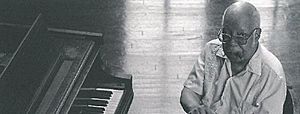William Oscar Smith facts for kids
Quick facts for kids
William Oscar (W.O.) Smith
|
|
|---|---|

William Oscar (W.O. Smith)
|
|
| Background information | |
| Born | May 2, 1917 Bartow, Georgia |
| Died | May 31, 1991 (aged 74) Nashville, Tennessee |
| Genres | Jazz, classical |
| Instruments | Double Bass, viola |
| Associated acts | Dizzy Gillespie, Coleman Hawkins |
William Oscar Smith (born May 2, 1917 – died May 31, 1991) was an amazing jazz musician who played the double bass. He was also a dedicated music teacher. Even though he didn't become a famous solo artist, he was a very important "sideman." A sideman is a musician who plays with other main artists.
W.O. Smith played bass on a super famous jazz song called "Body and Soul" in 1939 with Coleman Hawkins. Another jazz legend, Dizzy Gillespie, said that Oscar Smith was one of the most talented musicians he knew. Gillespie admired Smith's perfect timing and rhythm.
Contents
W.O. Smith's Early Life
W.O. Smith was born in Bartow, Georgia, on May 2, 1917. When he was just six months old, his family moved to Philadelphia, Pennsylvania. They moved because of the difficult challenges African Americans faced in their hometown at that time.
Smith grew up in Philadelphia. He went to Benjamin Franklin High School. He even lived in the same neighborhood as the future jazz star Dizzy Gillespie. Smith and Gillespie started their music careers together. They played in the Frankie Fairfax Band until 1937, when Gillespie moved away.
Education and Music
After high school, Smith went to Mastbaum Vocational School of Music. He then graduated from Lincoln University in 1937. After that, he moved to New York City to study at New York University (NYU).
During his time in New York, Smith played with many famous jazz musicians. These included Bessie Smith, Fats Waller, Dizzy Gillespie, and Coleman Hawkins. He made jazz history as the bassist on Coleman Hawkins' famous 1939 recording of "Body and Soul."
In June 1942, he earned his Bachelor's Degree from NYU. Smith continued his studies and later earned his Ph.D. from the University of Iowa.
Service and Teaching
During World War II, Smith was a band director for the U.S. Army. He was stationed in Fort Huachuca, Arizona. After his time in the military, he went back to New York for a short while. He worked as a musician there. It was also during this time that he started his long career as an educator. He taught at Seward Park High School in New York.
In 1945, Smith moved to Baltimore. He met Catherine Leeds there, and they got married in 1948. They had three children together: Jacqueline, Jay, and Joel.
Nashville and the Symphony
In 1952, W.O. Smith and his family moved to Nashville, Tennessee. There, he began teaching at Tennessee State University. In 1962, Smith became only the second Black musician to join the Nashville Symphony Orchestra. He played the double bass and viola with them for seventeen years. Smith also taught as a professor at the Blair School of Music at Vanderbilt University.
The W.O. Smith Music School
In 1984, Smith opened the W.O. Smith Music School in Nashville. His goal was to offer music lessons to families who couldn't afford them. When it first opened, the school had 45 students. Today, it is a modern facility that helps over 650 students learn music.
In his book, Smith described his life as being "a witness." He saw the birth and growth of jazz as an American art form. He also witnessed the important civil rights movement. He said, "It has been long and interesting gig for me."
W.O. Smith's Legacy
After a long illness, W.O. Smith passed away on May 31, 1991, in Nashville. Just before he died, he finished writing his memoir. It was called Sideman: The Long Gig of W.O. Smith, a Memoir. The book was published after his death in 1991. He is buried at Woodlawn Memorial Park Cemetery in Nashville.

